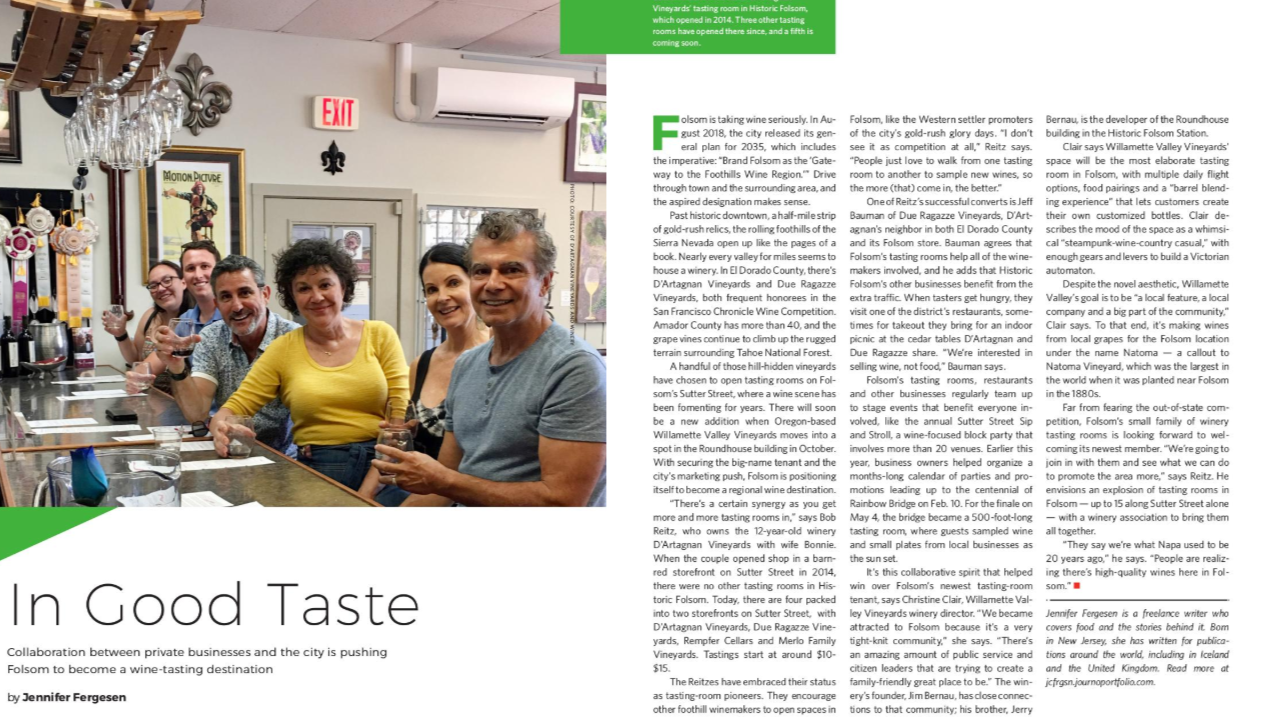In Good Taste: Wineries in Folsom

Folsom is taking wine seriously. In August 2018, it released its general plan for 2035, which includes the imperative: “Brand Folsom as the ‘Gateway to the Foothills Wine Region.’” Drive through town and the region, and the aspired designation makes sense.
Past historic downtown, a half-mile strip of gold-rush relics, the rolling foothills of the Sierra Nevada open up like the pages of a book. Nearly every valley for miles seems to house a winery. In El Dorado County, there’s D’Artagnan Vineyards and Due Ragazze Vineyards, both frequent honorees in the San Francisco Chronicle Wine Competition. Amador County has more than 40, and the grape vines continue to climb up the rugged terrain surrounding Tahoe National Forest.
A handful of those hill-hidden vineyards have chosen to open tasting rooms on Folsom’s Sutter Street, where a wine scene has been fomenting for years. There will soon be a new addition when Oregon-based Willamette Valley Vineyards moves into a spot in the Roundhouse building in October. With securing the big-name tenant and the city’s marketing push, Folsom is positioning itself to become a regional wine destination.
“There’s a certain synergy as you get more and more tasting rooms in,” says Bob Reitz, who owns the 12-year-old winery D’Artagnan Vineyards with wife Bonnie. When the couple opened shop in a barn-red storefront on Sutter Street in 2014, there were no other tasting rooms in Historic Folsom. Today, there are four packed into two storefronts on Sutter Street, with D’Artagnan Vineyards, Due Ragazze Vineyards, Rempfer Cellars and Merlo Family Vineyards. Tastings start at around $10-$15.
The Reitzes have embraced their status as tasting-room pioneers. They encourage other foothill winemakers to open spaces in Folsom, like the Western settler promoters of the city’s gold-rush glory days. “I don’t see it as competition at all,” Reitz says. “People just love to walk from one tasting room to another to sample new wines, so the more (that) come in, the better.”
One of Reitz’s successful converts is Jeff Bauman of Due Ragazze Vineyards, D’Artagnan’s neighbor in both El Dorado County and its Folsom store. Bauman agrees that Folsom’s proliferation of tasting rooms helps all of the winemakers involved and adds that Historic Folsom’s other businesses benefit from the extra traffic. When tasters get hungry, they visit one of the district’s restaurants, sometimes for takeout they bring for an indoor picnic at the cedar tables D’Artagnan and Due Ragazze share. “We’re interested in selling wine, not food,” Bauman says.
Folsom’s tasting rooms, restaurants and other businesses regularly team up to stage events that benefit everyone involved, like the annual Sutter Street Sip and Stroll, a wine-focused block party that involves more than 20 venues. Earlier this year, business owners helped organize a months-long calendar of parties and promotions leading up to the centennial of Rainbow Bridge on Feb. 10. For the climax of the bacchanal on May 4, the bridge became a 500-foot-long tasting room, where guests sampled wine and small plates from local businesses as the sun set.
It’s this collaborative spirit that helped win over Folsom’s newest tasting-room tenant, says Christine Clair, Willamette Valley Vineyards winery director. “We became attracted to Folsom because it’s a very tight-knit community,” she says. “There’s an amazing amount of public service and citizen leaders that are trying to create a family-friendly great place to be.” The winery’s founder, Jim Bernau, has close connections to that community; his brother, Jerry Bernau, is the developer of the Roundhouse building in the Historic Folsom Station.
Clair says Willamette Valley Vineyards’ space will be the most elaborate tasting room in Folsom, with multiple daily flight options, food pairings and a “barrel blending experience” that lets customers create their own customized bottles. Clair describes the mood of the space as a whimsical “steampunk-wine-country casual,” with enough gears and levers to build a Victorian automaton.
Despite the novel aesthetic, Willamette Valley’s goal is to be “a local feature, a local company and a big part of the community,” Clair says. To that end, it’s making wines from local grapes for the Folsom location under the name Natoma — a callout to Natoma Vineyard, which was the largest in the world when it was planted near Folsom in the 1880s.
Far from fearing the out-of-state competition, Folsom’s small family of winery tasting rooms is looking forward to welcoming its newest member. “We’re going to join in with them and see what we can do to promote the area more,” says Reitz. He envisions an explosion of tasting rooms in Folsom — up to 15 along Sutter Street alone — with a winery association to bring them all together.
“They say we’re what Napa used to be 20 years ago,” he says. “People are realizing there’s high-quality wines here in Folsom.”
